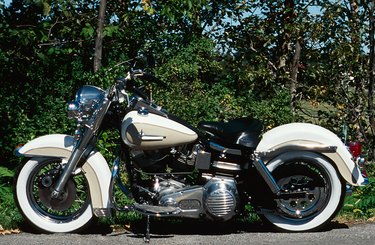
Properly called a hand-shifter, the terms "tank shift," "suicide shifter," "slap-shifter" and "jockey shift" all refer to a drivetrain that requires the rider to remove one hand from a motorcycle's handlebars to select and change gear. Harley-Davidson's Panhead, introduced for the 1949 model year and replacing the Knucklehead, featured a tank shift through its entire production run.
Hand-Shifter History
The hand-shifter was common on most motorcycles manufactured from the machine's invention until the 1950s. In most applications, a foot-operated clutch was depressed while the gears were selected with the hand-shifter. The design has seen a resurgence in the custom motorcycle industry, where it speaks to an earlier era and evokes a retro feel.
Typical Arrangement
The gearshift handle was mounted to the left side of the engine, connected at the bottom by a system of levers to the shift selector of the drivetrain. The top of the shifter most commonly projected upward through, and moved within, a notched gate similar to modern car shifters where a tiptronic-style stick is used.
Harley-Davidson’s Panhead
Panheads were introduced in 1949, and were thus christened by the public because the valve covers at the top of each cylinder resembled cake pans. Within a short time Panheads became popular bases for personalization and customization. With the return of airmen from World War II and the subsequent birth of the club and chopper culture, the complex linkage of the tank shift assembly became undesirable to some. Riders who wished to reduce the weight -- and, some would say, cluttered appearance of the dresser -- shortened the side-of-the-tank actuating lever so that the gear selection was made right at the gearbox itself.
The change from Knucklehead to Panhead featured a second profound change: iron cylinders were replaced by aluminum alloy. Previously, wartime demands had restricted the availability of aluminum, but with the end of the conflict, surplus planes were melted down and the raw material became widely available for reuse.
Hand-Shifters on the Panhead
The hand shifter-foot clutch combination was first used by Harley-Davidson in 1915, and the hand-operated clutch first appeared with the 1952 Panhead. Before the 1952 model year, Harley-Davidson used only a left-foot clutch to disengage the drivetrain, and a left-hand tank shifter to select gears. The reversed arrangement was introduced as an option, and both versions were available on the Panhead until production discontinued in 1965. Within two years of introduction, the hand-clutch, foot-shifter architecture was outselling the older style around 2-to-1.
Suicide Clutches
It should be noted that a suicide shifter and a suicide clutch are different; the latter describes a foot-operated clutch pedal that gave the rider a choice between putting both feet on the ground or holding in the left-foot-operated clutch. This effectively required the rider to prioritize either balance or disengaging the gears, a particularly onerous choice at T junctions.